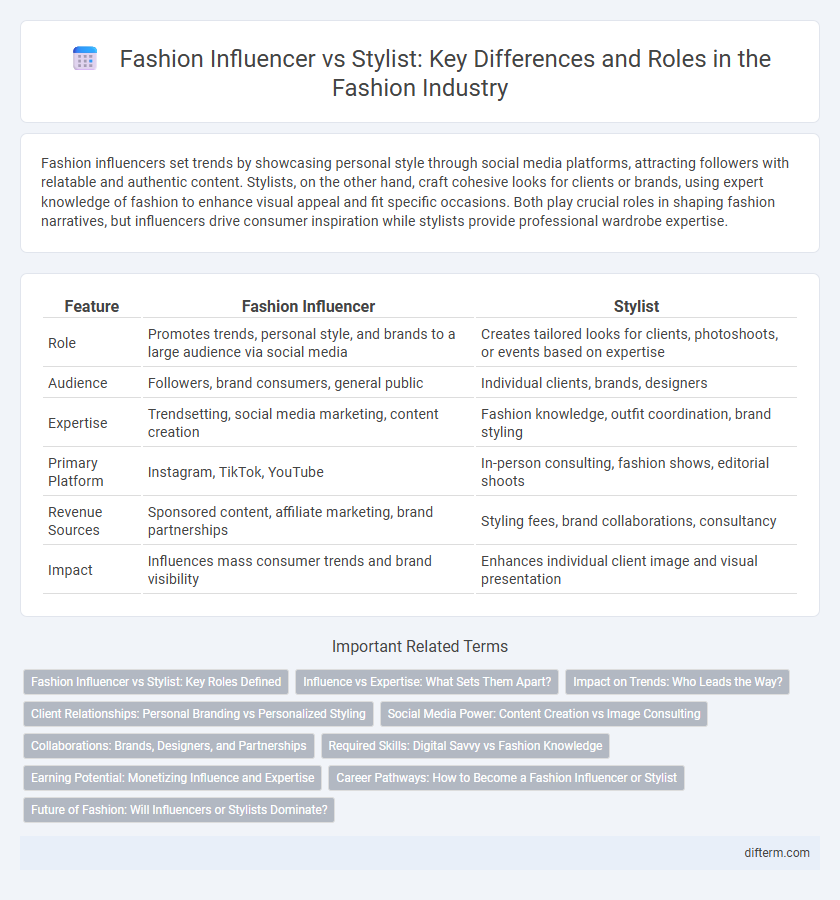Fashion influencers set trends by showcasing personal style through social media platforms, attracting followers with relatable and authentic content. Stylists, on the other hand, craft cohesive looks for clients or brands, using expert knowledge of fashion to enhance visual appeal and fit specific occasions. Both play crucial roles in shaping fashion narratives, but influencers drive consumer inspiration while stylists provide professional wardrobe expertise.
Table of Comparison
| Feature | Fashion Influencer | Stylist |
|---|---|---|
| Role | Promotes trends, personal style, and brands to a large audience via social media | Creates tailored looks for clients, photoshoots, or events based on expertise |
| Audience | Followers, brand consumers, general public | Individual clients, brands, designers |
| Expertise | Trendsetting, social media marketing, content creation | Fashion knowledge, outfit coordination, brand styling |
| Primary Platform | Instagram, TikTok, YouTube | In-person consulting, fashion shows, editorial shoots |
| Revenue Sources | Sponsored content, affiliate marketing, brand partnerships | Styling fees, brand collaborations, consultancy |
| Impact | Influences mass consumer trends and brand visibility | Enhances individual client image and visual presentation |
Fashion Influencer vs Stylist: Key Roles Defined
Fashion influencers curate and share personal style content on social media platforms, shaping trends through authentic engagement and brand collaborations. Stylists provide professional wardrobe expertise, selecting and coordinating outfits for clients, photoshoots, and events to create cohesive looks. Both roles drive fashion visibility but differ in approach: influencers build public personas while stylists offer tailored fashion solutions behind the scenes.
Influence vs Expertise: What Sets Them Apart?
Fashion influencers leverage their large social media followings to shape trends and consumer behavior through relatable content and personal style, emphasizing influence over formal training. Stylists possess specialized expertise, often gained through professional education and experience, enabling them to create tailored looks that meet specific client needs or editorial visions. The key distinction lies in influencers driving mass appeal and brand engagement, while stylists focus on technical skill, personalized fashion curation, and industry credibility.
Impact on Trends: Who Leads the Way?
Fashion influencers drive trends through widespread social media reach and real-time engagement, shaping consumer preferences with curated content and personal style. Stylists lead trend adoption by working directly with designers, celebrities, and fashion houses, translating runway looks into wearable, market-ready ensembles. The dynamic interplay between influencers' mass appeal and stylists' industry expertise ultimately propels fashion trends from concept to mainstream acceptance.
Client Relationships: Personal Branding vs Personalized Styling
Fashion influencers cultivate client relationships through personal branding by showcasing their unique style and engaging audiences via social media platforms, building trust through consistent content. Stylists develop personalized styling by directly understanding clients' individual needs, body types, and preferences to create tailored looks that enhance confidence and identity. Both roles emphasize client connection but differ in approach--public influence versus bespoke consultation.
Social Media Power: Content Creation vs Image Consulting
Fashion influencers harness the power of social media platforms like Instagram and TikTok to create engaging content that drives trends and audience engagement through personal style storytelling. Stylists focus on image consulting by curating and coordinating outfits tailored to client identities, enhancing visual appeal for public appearances and media representation. Both roles leverage digital presence, but influencers prioritize content creation for mass reach, while stylists emphasize personalized image strategy and client branding.
Collaborations: Brands, Designers, and Partnerships
Fashion influencers drive brand visibility by leveraging social media platforms to showcase collaborations with designers and fashion houses, creating authentic connections with their audience through personal styling. Stylists collaborate directly with designers and brands, curating looks for editorial shoots, runway shows, and celebrity clients, often influencing trends behind the scenes. Partnerships with influencers amplify marketing campaigns, while stylists ensure cohesive brand aesthetics, both playing crucial roles in the fashion industry's collaborative ecosystem.
Required Skills: Digital Savvy vs Fashion Knowledge
Fashion influencers excel in digital savvy, mastering social media platforms, content creation, and audience engagement to build strong personal brands. Stylists prioritize deep fashion knowledge, including trend forecasting, garment fitting, and creating cohesive looks tailored to clients. Both roles require a blend of creativity and industry insight, but influencers lean towards technical digital skills while stylists emphasize expert fashion expertise.
Earning Potential: Monetizing Influence and Expertise
Fashion influencers monetize their social media presence through sponsorships, affiliate marketing, and brand collaborations, often earning substantial income by leveraging their follower base. Stylists generate revenue by offering personalized wardrobe consulting, working with clients on photoshoots or events, and sometimes partnering with fashion brands for exclusive projects. The earning potential for influencers typically scales with audience engagement, while stylists benefit from niche expertise and long-term client relationships.
Career Pathways: How to Become a Fashion Influencer or Stylist
Aspiring fashion influencers build their career by growing a strong social media presence through consistent content creation, brand collaborations, and audience engagement, often starting as bloggers or Instagram curators. Stylists typically pursue formal education or internships in fashion styling, gaining experience by assisting established stylists and developing a portfolio that showcases their ability to curate looks for clients or editorial projects. Both career pathways demand networking within the fashion industry and staying updated on trends to maintain relevance and secure professional opportunities.
Future of Fashion: Will Influencers or Stylists Dominate?
Fashion influencers leverage social media platforms to shape trends through personal branding and direct audience engagement, while stylists offer professional expertise and curated looks for clients and media. The future of fashion may see a convergence where influencers integrate stylist skills, blending authenticity with professional styling, driven by digital innovation and consumer demand for personalized experiences. Data from marketing analyses indicates that collaborations between influencers and stylists boost brand visibility and consumer trust, suggesting a hybrid model will dominate the fashion landscape.
fashion influencer vs stylist Infographic

 difterm.com
difterm.com